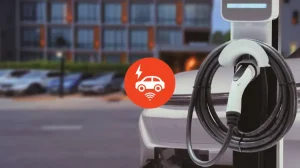Modern technology is constantly making life easier and more convenient, including parking. Over the last decade, the parking sector has witnessed a number of technological innovations: sensors and cameras to monitor the occupancy of parking spaces, mobile apps that show free parking spaces in public and/or indoor areas, or even provide the possibility to pay for and (sometimes) reserve parking, as well as automatic number plate recognition (ANPR) systems. Smart infrastructure and the use of IoT solutions have fundamentally changed the potential of what parking can offer, enabling better management of demand, optimisation of supply and higher levels of consumer satisfaction.
The aim of this article is to present the main benefits of today’s smart parking solutions with a focus on smart parking sensors, and to explore further potential applications for them.
What are parking spot sensors and how do smart parking sensors work?
If you’re familiar with the subject, feel free to skip this paragraph, but if you’re still exploring this area, here’s a quick summary of what you need to know about parking sensors.
IoT-based smart parking sensors use various detection mechanisms, such as magnetometers or radar, to detect the occupancy status of a parking space, which is then transmitted to a central system for further use. An example is the display of available parking spaces in an app for drivers.
While this is the most reliable way to collect occupancy data, there are also camera-based alternatives. In a previous article, we have already discussed the main differences between the two technologies as well as the detection mechanisms of the sensors. To learn more about Smart Lynx’s parking sensors, have a look at our Smart Parking Sensor dedicated page.
Creating value in parking – data, data, data
One of the greatest assets for a parking operator – whether in cities or P+R car parks – is the data collected by sensors. The revenue-generating parking space is a scarce resource with limited or no expansion of capacity. Managing parking spaces in the most optimal way possible is therefore of key importance, which is made possible by data-driven operations and decision making. There are many benefits and uses of building a smart parking system, let’s review the most important ones:
Increased efficiency. Parking spaces equipped with parking sensors provide an accurate insight into space occupancy, ensuring efficient management of the parking infrastructure. With real-time occupancy data, drivers can straight away navigate to available spaces, which improves parking occupancy and revenue while reducing congestion. Such system operates in Budapest’s 5th and 13th districts, allowing drivers to find free on-street parking spaces in real time using the Parker app. The potential applications of parking data are limited only by the imagination: among other things, it is possible to monitor the real-time occupancy of loading, disabled and electric charging bays, providing the opportunity to efficiently reallocate spaces. Moreover, the route of parking attendants can also be optimised, as they can systematically inspect places where new parking events have occurred.
Dynamic pricing. It is common practice in many industries, such as airlines and hotels, but is relatively rare in the parking sector. In Madrid, for example, a new pricing system was introduced in 2014, whereby parking fees depend on the vehicle’s emissions and the current occupancy rate of the parking spaces, meaning that parking seekers have to pay higher fees during busier periods. Every vacant parking space represents a loss of profit for both private and public parking operators, but dynamic pricing based on current occupancy provides a unique opportunity to maximise parking revenues.
Value added services. In principle, the fact that customers or residents looking for a parking space know exactly where to find a free space is already a quality-enhancing service, but it is only one of many opportunities to be exploited. For example, by differentiating between different types of parking spaces – whether disabled, loading or electric charging – users can find out where the spaces that are relevant to them are located and whether they are available. Sensors can also be complemented with RFID technology to verify that only authorised users are parking in a given space by identifying the parked vehicle. The introduction of a parking reservation system, which allows drivers to reserve and pay for their parking space in advance, could also add value by eliminating the stress and uncertainty of searching for a free parking space.
User and environmental benefits. The deployment of smart parking systems also benefits drivers. They spend less time searching for parking spaces, which means less unnecessary driving, not only saving them stress and extra fuel consumption, but also providing environmental benefits through lower emissions. As a result, air quality and noise pollution in the area is reduced.
How much does an in-ground parking sensor cost?
The price of smart parking sensors ranges widely, with cheap Chinese solutions starting from just $70. If you choose these sensors, you will probably have to compromise on quality, as the sensors may run out of battery, stop working or, most likely, not be accurate enough.
If you want the highest possible reliability and lifetime, you will have to pay a higher price. The cost of deploying a complete system depends largely on the number of parking spaces, as smart parking sensors need to be installed in each parking space, either it is a flush-mount or surface-mount construction. Fortunately, the installation of NB-IoT parking sensors is cost-effective, as the sensors communicate via the existing mobile network. Moreover, they require no external power source thanks to the use of batteries, so there is no need to install any other elements (e.g. local network, repeater, etc.) than the sensors.
Lifetime is a key factor in choosing the right sensor, as the entire device usually needs to be replaced after it runs out of battery power. In most cases, it is possible to replace the batteries only, but this is generally not a recommended procedure, as the other, typically very sensitive, components in the sensor will wear out over several years. Smart Lynx’s smart parking sensors stand out with a lifetime of over 5 years. A further benefit is the special design of the sensor housing, which ensures that no new drilling is required to replace the sensor.
Conclusion
We believe that the only way to succeed in the parking sector in the future is by continuously developing resources through innovative solutions and by exploiting the potential of available smart parking technologies. This will improve the customer experience while optimising the operation of parking infrastructures. Smart Lynx’s Smart Parking and Ticketless Parking solutions offer the essential tools to achieve this.





